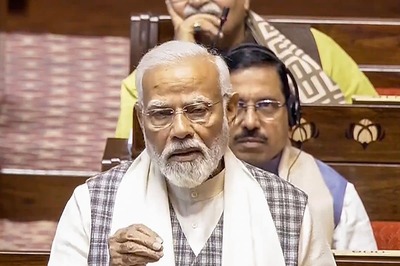
views
The Bangladesh strain of the Nipah virus manifests breathlessness issues and kills nine out of 10 infected individuals, the country’s top epidemiologist Dr Raman Gangakhedkar told News18 on Saturday, sounding caution that it is of the utmost importance to find out the source of the virus to prevent its spread.
Gangakhedkar, the former head of epidemiology and communicable diseases, Indian Council of Medical Research (ICMR), steered the country’s effort in handling the last three outbreaks of the Nipah virus in Kerala.
“Top priorities are finding the index patient, finding the origin of Nipah virus, testing all the animals around, mobilising the community and keeping medical aid ready," he said.
On September 13, Kerala Health Minister Veena George announced that the Nipah cases detected in the state were of the Bangladesh strain.
Speaking to News18, Gangakhedkar said that the circulating strain is known to cause respiratory distress syndrome, which makes patients feel breathless among the initial symptoms and pushes them on ventilators.
“The Malaysian strain is known for manifesting neurological symptoms but the Bangladesh strain is known for higher case fatality rate or deaths… It will kill nine people out of 10 infected, approximately," he said, adding that 89% of patients died out of 23 infected patients in the first outbreak.
Nipah Mystery a ‘Crime Thriller’
Gangakhedkar, who was the face of India’s apex medical research agency during the government briefings on Covid-19, believes that solving the mystery of the Nipah virus – reaching out to the index patient, finding the origin of the virus, connecting the events linking origin to the index patient and tracing everyone in contact with index patient – is like watching in a “crime thriller" unfold.
“It is a jigsaw puzzle," he said, recalling that, in 2018, he and other team members solved the Nipah mystery in 15 days.
In May 2018, a team of scientists found that the index patient was in direct contact with the fruit bats while cleaning the well of his house in a village in Kerala.
“In Kerala, the bats come to eat fruits in the orchards. In 2018 and 2019, the outbreak happened in the month of May, which threw up a clue that they come to eat mangoes in summer. Hence, the advisory was issued to consume fruits after washing them or not to touch bitten fruits."
In September 2021, there was another outbreak. However, the experience with quarantine and isolation during the Covid-19 pandemic proved beneficial in handling Nipah, as there was a heightened level of public compliance in wearing masks and following safety measures.
Gangakhedkar emphasised the necessity of identifying new connections at this point, given that the outbreak has recurred for the second time in September.
“Contact-tracing should be very heavy," Gangakhedkar said, recalling that in 2018, more than 2,000 people were tracked and traced in just three days.
Why Kerala
An ongoing nationwide survey by the Pune-based ICMR’s National Institute of Virology (ICMR-NIV) has found evidence of the Nipah virus circulation in the bat population across nine states and one Union Territory.
Till July, the survey was completed in 14 states and two Union Territories. The presence of Nipah viral antibodies was found in bats in Kerala, Tamil Nadu, Karnataka, Goa, Maharashtra, Bihar, West Bengal, Assam, Meghalaya and the Union Territory of Pondicherry.
Quoting the same study, Gangakhedkar said, “There is a possibility that small outbreaks happen in other states but are not reported. We need to strengthen our surveillance mechanism."
India needs to look at Bangladesh’s model where they have fought the virus through public education and common mobilisation, he said.
“Apart from many other preventive techniques, they have started covering palm trees to stop the nesting of bats."
According to the septuagenarian scientist, “Kerala is unique and has well-oiled machinery to handle such outbreak. The state’s health machinery is also healthy where community mobilisation and sensitisation is taken very seriously by the common man."
The Treatment
India has reached out to Australia to acquire more monoclonal antibody doses to combat the Nipah virus. According to Dr Rajiv Bahl, the head of the ICMR, India expects to receive an additional 20 doses soon.
The monoclonal antibody – which successfully completed its phase-one trial and has been administered to a total of 14 individuals globally so far – was first ordered in 2018.
“We ordered these products in the first outbreak. However, by the time they reached India, the outbreak was over."
The leftover doses are being used now by the Indian authorities.
Gangakhedkar said that, in 2021, India was already in talks with US-Australia for manufacturing the monoclonal antibodies likely to be used against Nipah.
“This therapy is being developed in a joint research project of the US and Australia. We requested to start production of these antibodies in India for non-commercial purposes," he said, adding that the project slipped to the backburner after the outbreak of Covid-19.



















Comments
0 comment